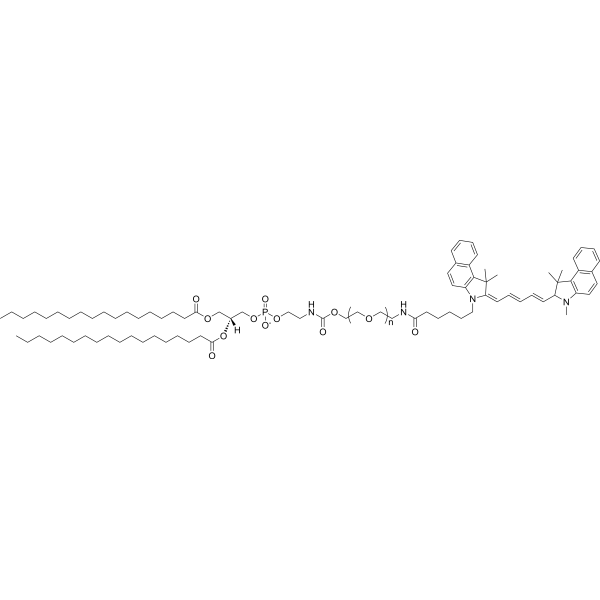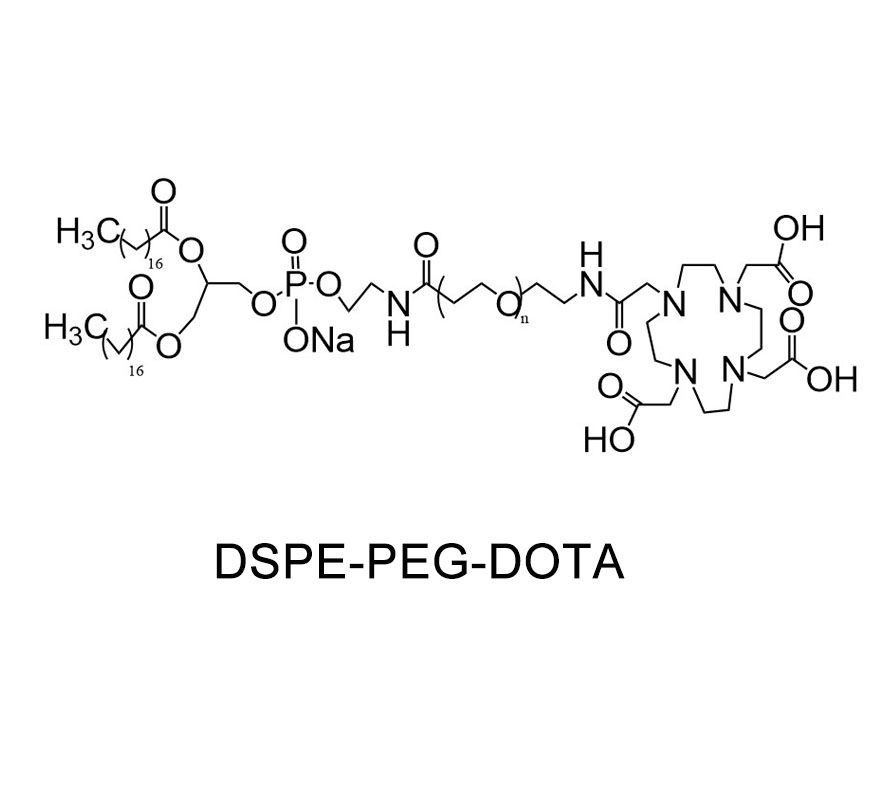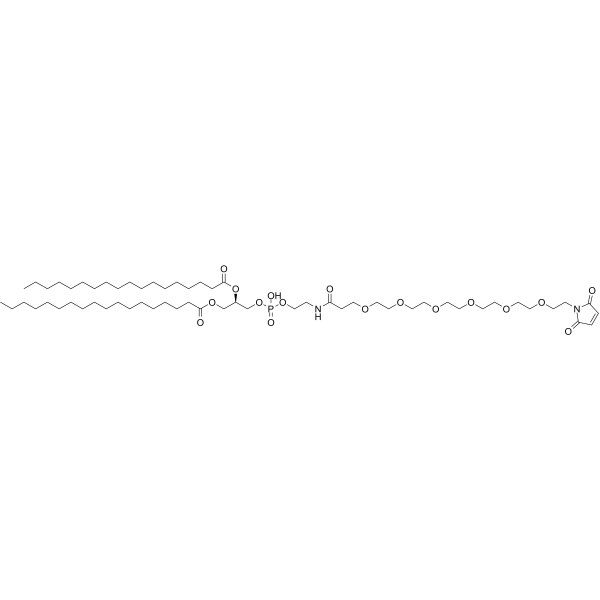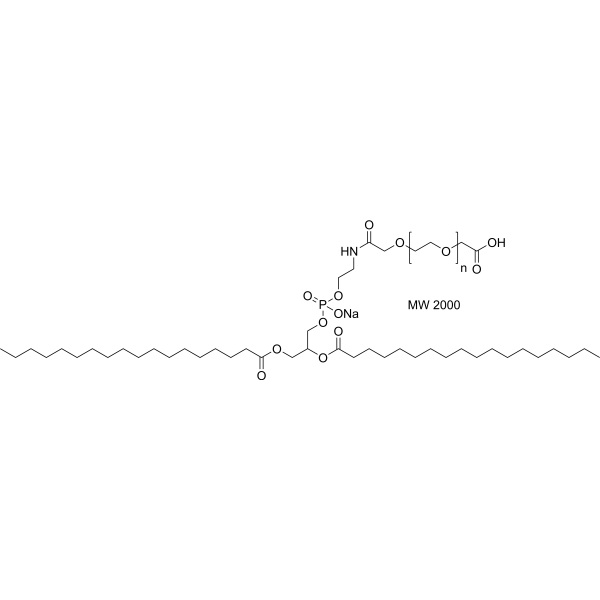 To enhance service speed and avoid tariff delays, we've opened a US warehouse. All US orders ship directly from our US facility.
To enhance service speed and avoid tariff delays, we've opened a US warehouse. All US orders ship directly from our US facility.
| Cat. No. | Product Name | Field of Application | Chemical Structure |
|---|---|---|---|
| DC66264 | DSPE-Hyd-PEG-N3 Featured |
DSPE-Hyd-PEG, also known as distearoylphosphoethanolamine-hydrazide-polyethylene glycol, is a type of lipid-based polymer that has various applications in drug delivery and biomedical research.
One of the main applications of DSPE-Hyd-PEG is in the field of targeted drug delivery. It is often used as a component of liposomes or lipid nanoparticles to improve the stability and targeting ability of drug carriers. DSPE-Hyd-PEG can be conjugated with targeting ligands, such as antibodies or peptides, to specifically bind to receptors on the surface of target cells. This targeted drug delivery system allows for more efficient and selective delivery of therapeutic agents to the desired site, while minimizing off-target effects.
More description
|

|
| DC66263 | DSPE-Hyd-PEG-OH Featured |
DSPE-Hyd-PEG, also known as distearoylphosphoethanolamine-hydrazide-polyethylene glycol, is a type of lipid-based polymer that has various applications in drug delivery and biomedical research.
One of the main applications of DSPE-Hyd-PEG is in the field of targeted drug delivery. It is often used as a component of liposomes or lipid nanoparticles to improve the stability and targeting ability of drug carriers. DSPE-Hyd-PEG can be conjugated with targeting ligands, such as antibodies or peptides, to specifically bind to receptors on the surface of target cells. This targeted drug delivery system allows for more efficient and selective delivery of therapeutic agents to the desired site, while minimizing off-target effects.
More description
|

|
| DC66262 | DSPE-Hyd-PEG-FA Featured |
DSPE-Hyd-PEG, also known as distearoylphosphoethanolamine-hydrazide-polyethylene glycol, is a type of lipid-based polymer that has various applications in drug delivery and biomedical research.
One of the main applications of DSPE-Hyd-PEG is in the field of targeted drug delivery. It is often used as a component of liposomes or lipid nanoparticles to improve the stability and targeting ability of drug carriers. DSPE-Hyd-PEG can be conjugated with targeting ligands, such as antibodies or peptides, to specifically bind to receptors on the surface of target cells. This targeted drug delivery system allows for more efficient and selective delivery of therapeutic agents to the desired site, while minimizing off-target effects.
More description
|

|
| DC66261 | DSPE-Hyd-PEG-SH Featured |
DSPE-Hyd-PEG, also known as distearoylphosphoethanolamine-hydrazide-polyethylene glycol, is a type of lipid-based polymer that has various applications in drug delivery and biomedical research.
One of the main applications of DSPE-Hyd-PEG is in the field of targeted drug delivery. It is often used as a component of liposomes or lipid nanoparticles to improve the stability and targeting ability of drug carriers. DSPE-Hyd-PEG can be conjugated with targeting ligands, such as antibodies or peptides, to specifically bind to receptors on the surface of target cells. This targeted drug delivery system allows for more efficient and selective delivery of therapeutic agents to the desired site, while minimizing off-target effects.
More description
|

|
| DC66151 | DSPE-TK-PEG-NH2 Featured |

|
|
| DC44401 | DSPE-PEG14-COOH Featured |
DSPE-PEG14-COOH is a PEG-based PROTAC linker that can be used in the synthesis of PROTACs.
More description
|

|
| DC66134 | DSPE-SS-PEG-CY5 Featured |

|
|
| DC66132 | DSPE-SS-PEG-CY7 Featured |

|
|
| DC66131 | DSPE-SS-PEG-CY3 Featured |

|
|
| DC66154 | DSPE-TK-PEG-NPC Featured |

|
|
| DC66144 | DSPE-SS-PEG-NH2 Featured |

|
|
| DC66136 | DSPE-SS-PEG-CHO Featured |

|
|
| DC66153 | DSPE-TK-PEG-CHO Featured |

|
|
| DC66152 | DSPE-TK-PEG-FA Featured |

|
|
| DC66143 | DSPE-SS-PEG-SH Featured |

|
|
| DC66140 | DSPE-SS-PEG-FA Featured |

|
|
| DC66138 | DSPE-SS-PEG-RB Featured |

|
|
| DC66126 | DSPE-SS-PEG-N3 Featured |
Phospholipids are commonly used polymeric gene carriers. DSPE with high molecular weight can effectively compound DNA, and has strong buffered capacity under endosomal pH conditions, showing good transfection efficiency for a variety of cells. However,DAPE is not easily degraded, and high molecular weight DAPE as a gene carrier may lead to short - or long-term cytotoxicity.
More description
|

|
| DC66106 | DSPE-Maleimide Featured |

|
|
| DC66299 | DSPE-PEG-Cy5.5 Featured |
DSPE-PEG-Cy5.5is a phospholipid. Phospholipids have good biocompatibility and significant amphiphilic characteristics, making them the main and suitable dosage form or excipient in drug formulations, thereby achieving better therapeutic effects. "&B26&"can be used in drug delivery research."
More description
|

|
| DC66280 | DSPE-PEG-DOTA Featured |
Macrocyclic ligands are ring complexes formed by multi-dentate ligands with O, N, P, S and other coordination atoms on the ring skeleton. The range of complexes is wide. According to their structural characteristics, complexes can be divided into the following types: simple complexes, chelates, polynuclear complexes, carbonyl complexes, metal clusters, sandwich complexes, and macrocyclic ligand complexes.
More description
|

|
| DC66148 | DSPE-TK-PEG-SH Featured |
The polymer with ketone mercaptan as the fragment can form the shell of the nanocore, and simultaneously contain the polyorubicin and light sensitive compounds to achieve dual roles. Ketothiol polymers can also be used directly as drug carriers to contain paclitaxel ROS responsive groups, often in combination with a variety of methods. ROS, as the connecting part, connects the hydrophilic part and the hydrophobic part of the nanocarrier. When the nanocarrier encounters ROS, it breaks and releases drugs: the ROS responsive group can also act as the part connecting drug molecules and nanocarriers to release drugs under oxidation. Common ROS responsive groups generally contain sulfur, boron and tellurium. In addition, in order to inactivate the protein, ROS responsive groups can also be used to block the active center of the protein. Common ROS responsive genes include: polypropylene sulfide, borate, thione, tellurium, selenium, ferrocene, anthocyanins, etc.
More description
|

|
| DC66291 | DSPE-PEG-OPSS Featured |
DSPE-PEG-OPSS, DSPE (1,2-distearoyl-sn-glycerol-3-phosphoethanolamine) is a saturated 18 carbon phospholipid, commonly used in the synthesis of liposomes. Polyethylene glycol (PEG) - coupled DSPE is hydrophilic and can be used for drug delivery, gene transfection and biomolecular modification. The PEG of phospholipid significantly improved the blood circulation time and stability of the capsule drug. Polyethylene glycol can enhance the solubility and stability, reduce the non-specific binding of charged molecules on the surface, and reduce the immunogenicity of polypeptides. Mercaptopyridine reacts with mercapto group to release pyridine ring and generate stable disulfide bond.
More description
|

|
| DC44305 | DSPE-PEG6-Mal Featured |
DSPE-PEG6-Mal is a PEG-based PROTAC linker that can be used in the synthesis of PROTACs.
More description
|

|
| DC44304 | DSPE-PEG2-mal Featured |
DSPE-PEG2-mal is a PEG-based PROTAC linker that can be used in the synthesis of PROTACs.
More description
|

|
| DC66116 | DSPE-PEG-FITC Featured |
DSPE-PEG-FITC, is a fluorescein attached PEG lipid. It can be used to prepare liposomes as drug carrier in targeted drug delivery. The polymer is modified with fluorescein (green) dye which can be used for staining cells, tissues, biomarkers, or nanoparticles.
More description
|

|
| DC66109 | DSPE-PEG-COOH Featured |
DSPE-PEG Carboxylic acid (sodium), MW 2000 is a PEG-lipid that can be used to form micelles as nanoparticles for drug delivery. DSPE-PEG Carboxylic acid (sodium), MW 2000 increases the blood circulation time of liposomes.
More description
|

|
| DC66292 | DSPE-PEG-NPC Featured |
DSPE-PEG-NPC is a linear heterobifunctional polyglycolation reagent containing DSPE phospholipids and NPC groups. It is a useful self-assembly reagent for preparing PEGylated liposomes or micelles, and also provides a combination of NPC group and thiol containing molecules.
More description
|

|
| DC66110 | DSPE-PEG-NHS Featured |
NHS PEG DSPE can be easily incorporated into liposomes and other nanoparticles through the reaction of NHS with amine. DSPE peg NHS is one of the most commonly used reactive phospholipids that bind antibodies, proteins, peptides or other substrates to the surface of liposomes and other lipid peg nanoparticles. Pegylated phospholipids have longer blood circulation time and higher encapsulation molecular stability. We have developed a series of chemically reactive phospholipid peg products with high purity, various molecular weights and excellent chemical reactivity. These lipid peg conjugates exhibit excellent amphiphilic properties and provide superior advantages for the modification, preparation and transportation of small and large molecules.
More description
|

|
| DC66295 | DSPE-PEG-CY7 Featured |
Polyethylene glycol phospholipid is an excellent material to form liposomes, which can be used for gene transfection, vaccine delivery, drug transportation, and targeted drug delivery. Phospholipids are hydrophobic and hydrophilic. It can be used to modify protein drugs, peptide compounds, organic small molecule drugs, biological materials, etc. Cy7 labeled PEG derivatives are used for fluorescence tracing or fluorescence observation.
More description
|

|